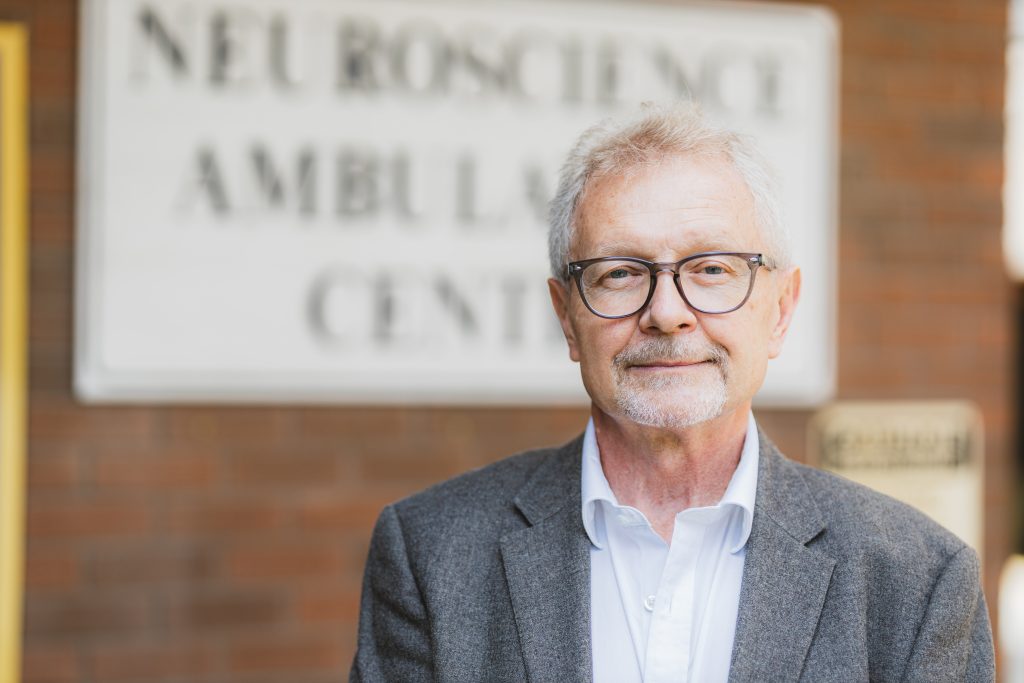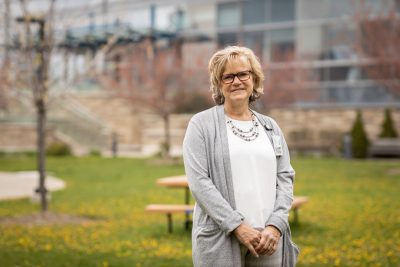
Passing the baton to the next generation of HHS stroke care doctors, researchers
What a difference 30 years makes – especially in stroke care and research.
When neurologist Dr. Wes Oczkowski joined Hamilton Health Sciences (HHS) in the early 1990s, the only approved medication for treating stroke was aspirin.
The clot buster drug tPA – now used to treat up to 15 per cent of stroke patients regionally – was still in the research phase and therefore not available to patients, and stroke clot retrieval didn’t exist.
Treating stroke was made even more challenging by an almost complete lack of public awareness.
“People didn’t recognize the signs or understand the importance of getting to hospital right away, so they were putting their lives at risk by staying at home instead of calling 9-1-1,” says Oczkowski, who specializes in stroke and rehabilitation. “When these patients eventually made it to hospital, there was very little that could be done for them at that point.”
40 years in medicine
Oczkowski retires this month – which also happens to be Stroke Month — after an illustrious 40-year career in medicine.
“I couldn’t help but feel excited about a career in stroke care.” — Dr. Wes Oczkowski
His many leadership positions spanned organizations including HHS, McMaster University, the Regional Stroke Network for Central South Ontario and the Population Health Research Institute (PHRI), a joint institute of HHS and McMaster. Together with colleagues at these organizations and others, Oczkowski helped established Hamilton as a leader in stroke care and research nationally and internationally.
“Wes has been instrumental in changing the landscape for stroke and putting Hamilton Health Sciences on the world stage for stroke care and research,” says Louise MacRae, director of regional neurosciences and the medicine program for HHS.
“Creating such an extensive network is a huge and complex undertaking.” — Louise MacRae, director of regional neurosciences and the medicine program.

Louise MacRae, director of regional neurosciences and the medicine program for HHS
At HHS’ Hamilton General Hospital (HGH), where Oczkowski is based, his many contributions included leading the opening of the Integrated Stroke Unit. He was also director of the Regional Stroke Centre for Central South Ontario, located at HGH, for 22 years. Under his leadership, a system was created that today includes HGH as the Regional Stroke Centre with District Stroke Centres at the Niagara Health System, Brant Community Health System and Grand River Hospital in Kitchener, as well as stroke prevention clinics at HHS, Niagara General Hospital, Joseph Brant Hospital, Brantford General Hospital, and Grand River Hospital.
“Creating such an extensive network is a huge and complex undertaking,” says MacRae. “Wes’ expertise and gift for connecting with people played a major role in making this regional network possible.”
Finding inspiration in early research
As a young McMaster University medical student in the late 1970s, Oczkowski was drawn to stroke care by groundbreaking research discoveries happening through a partnership between McMaster and Western universities. This included the breakthrough finding that aspirin can help prevent blood clots from forming in arteries, reducing the risk of stroke or heart attack.
After finishing internal medicine training, he went on to complete his neurology training at Western in London.
“Between the two cities I was studying in the mecca for stroke research and care in Canada, and probably North America,” says Oczkowski. “I couldn’t help but feel excited about a career in stroke care.”
From London, Oczkowski moved back to Hamilton, spending a year working in a lab studying clot buster therapy. “It was the late 80s, and the science coming out of Hamilton led to the development of clot buster treatment in stroke care.” At McMaster, he was mentored by leaders in thrombosis care including Drs. Jack Hirsh and Jeffery Weitz.
He joined HGH in the early 1990s, becoming one of the hospital’s first stroke neurologists along with Drs. Robert Duke and John Paulseth. This small but mighty team was involved in early international trials for clot buster therapy.
Stroke care today
Today, Hamilton continues to be a leader in stroke care and research, nationally and internationally. Thirteen stroke neurologists work at HGH, including world leaders in the field. A stroke neurology fellowship training program through the Boris Foundation is developing the next generation of world experts.
“When tPA was made available to patients in 2002, only one to two per cent of the population was receiving this life-saving treatment because the importance of getting to hospital quickly wasn’t understood,” says Oczkowski.
In this region, up to 15 per cent of patients are now being treated with the clot buster tPA, which stops a stroke by breaking up the blood clot. The key to its success is fast administration, so public awareness is vitally important to treating stroke quickly.
Know the FAST signs
There’s growing awareness of the FAST signs — which include calling 9-1-1 immediately and always taking an ambulance — since paramedics are trained to take patients to hospital sites specializing in stroke care. Following FAST signs helps save lives and reduces the severity of a stroke, even reversing some of the effects.
Stroke specialists are also treating some of the most severe strokes by inserting a catheter directly into the brain and removing the clot to open up circulation. Thanks to this procedure, some patients who would have spent their lives completely bedridden in long-term care are now able to live independently in their own homes.
Today’s patients are also cared for on stroke units by specialized teams, and are referred to specialized stroke recovery rehab.
All these advancements have combined to bring much better outcomes for patients. And they all happened under the leadership of Oczkowski and his colleagues.
Passing the baton
“There’s still much to do, but Hamilton’s stroke care and research is in excellent hands,” says Oczkowski, who is stepping away from the world of medicine for new pursuits that include spending more time with his six grandkids. He’s also taken up new interests like learning to play guitar and cook gourmet-level meals.
`Dabbling’ isn’t an option for this high achiever, who instead finds deep satisfaction in learning new skills and excelling at them.
“There’s a joy and peacefulness that comes from doing something well,” says Oczkowski, citing Mihaly Csikszentmihalyi’s book, Flow: The Psychology of Optimal Experience, as his inspiration.
The Hungarian-American psychologist writes about a state of consciousness called `flow’ where people experience deep enjoyment, creativity, and a total involvement with life by performing activities intuitively.
“That’s the place I want to get to in all these retirement activities,” says Oczkowski. “I think it’s the place where people are happiest and most fulfilled.”
Hamilton lawyer Mark Scholes has been best friends with Dr. Oczkowski for four decades. A few years ago Mark also became his patient. Read Mark’s story and heartwarming retirement message.





